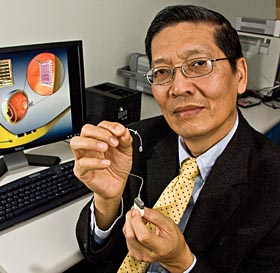Wentai Liu is an electronics wizard whose work is enabling the development of devices once found only in the realm of science fiction--miniaturized electronic implants to restore vision, movement, and other biological functions lost to disease or injury. A professor of electrical engineering at UC Santa Cruz, Liu is a pioneer in the field of bioelectronics, collaborating with medical doctors and other researchers on ambitious projects that have already achieved remarkable results.
"My lab is not an ordinary electronics lab," Liu says. "In bioelectronics, we have collaborators in many different fields, from plastic surgery to neurophysiology."
Liu's group at UCSC is working on a variety of neural prostheses designed to communicate directly with the nervous system in patients with blindness, paralysis, spinal cord injury, and other conditions long considered incurable. Medical researchers turn to Liu not only for his expertise in electronics but also for his experience in working with clinicians to address the many challenges at the interface between biological systems and electronics.
Liu's work in this area began in the 1980s with a project to develop an artificial retina to restore vision in blind patients. Led by Dr. Mark Humayun, an ophthalmologist and bioengineer, Liu and other members of the team have spent years designing, testing, and refining the experimental retinal implants. In 2002, the first patient received a retinal implant and within weeks was able to see patterns of light and dark, perceive motion, and detect large objects.
Six patients received that first experimental retinal prosthesis, and clinical trials are now under way with a more advanced second-generation implant, with Liu's electronics at the core of the device. The ultimate goal of the project--which now involves researchers at three universities, several national laboratories, and a private company--is to give patients the ability to recognize faces and read large print.
"In the 1980s, the retinal prosthesis was a crazy idea," says Mohan Sivaprakasam, who earned his Ph.D. with Liu and is now a research scientist managing Liu's lab of about 20 graduate and undergraduate students. "Wentai is always looking for the next frontier. If someone says it can't be done, that's the problem he wants to work on."
Liu's group is now involved in efforts to develop neural prostheses for restoring mobility to patients with spinal cord injury, treating facial paralysis, and providing brain stimulation to treat chronic pain and depression. Funding, which amounts to about $1 million a year for Liu's lab, comes from a wide range of government agencies, including the National Institutes of Health, National Science Foundation, Department of Energy, and Department of Defense.
According to Liu, the engineering challenges are fundamentally similar for all neural prostheses. They include minimizing the size and power requirements of the implanted device, delivering power to it without the use of penetrating wires, and managing bidirectional communication and data transmission between implanted and external components.
The retinal prosthesis, for example, involves a small video camera (integrated into a pair of sunglasses), external electronics to process and transmit the visual signals captured by the camera, and a tiny implant inside the eye to receive the signals and deliver electrical impulses through an array of microelectrodes that stimulate the neurons in the retina. The device can help patients blinded by diseases such as retinitis pigmentosa and age-related macular degeneration, which affect the light receptors in the retina but not the neural wiring from the eye to the brain.
Dr. Kimberly Cockerham, a neurological ophthalmologist at Stanford University, began working with Liu in 2006 on an implant to stimulate paralyzed facial muscles using a combination of electrical impulses and chemical neurotransmitters. The hybrid electrochemical implant may provide more comfortable and effective muscle stimulation than electrical impulses alone, and could potentially be used to stimulate paralyzed muscles anywhere in the body.
"It's a device that could be modified to meet a lot of clinical needs," Cockerham says.
Liu's most ambitious project is an effort to restore mobility to patients with spinal cord injuries. The project involves researchers at the U.S. Department of Veterans Affairs, Arizona State University, and other institutions. The aim is to bypass the injured spinal cord and deliver signals from the brain to the muscles in the legs
via a prosthetic system.
"The hope is to enable patients to stand up and walk," Liu says. "It requires an implant to record the brain signal and transmit it outside the body, and then the signals have to be processed and transmitted back into the body to a large number of implants in the leg--and it all has to happen at very high data rates."
Much of the work done by Liu's group involves juggling the many competing technical requirements and constraints of devices that not only involve highly sophisticated electronics, but also must function safely inside the body and interact with living tissue. Miniaturizing and integrating the components so as to optimize the overall performance of the device is a major challenge.
"There's no book for this," says Sivaprakasam. "It involves a lot of back and forth between the engineers and the clinicians--that collaboration is the key for these interdisciplinary projects."
Contact the author at stephens@ucsc.edu.



